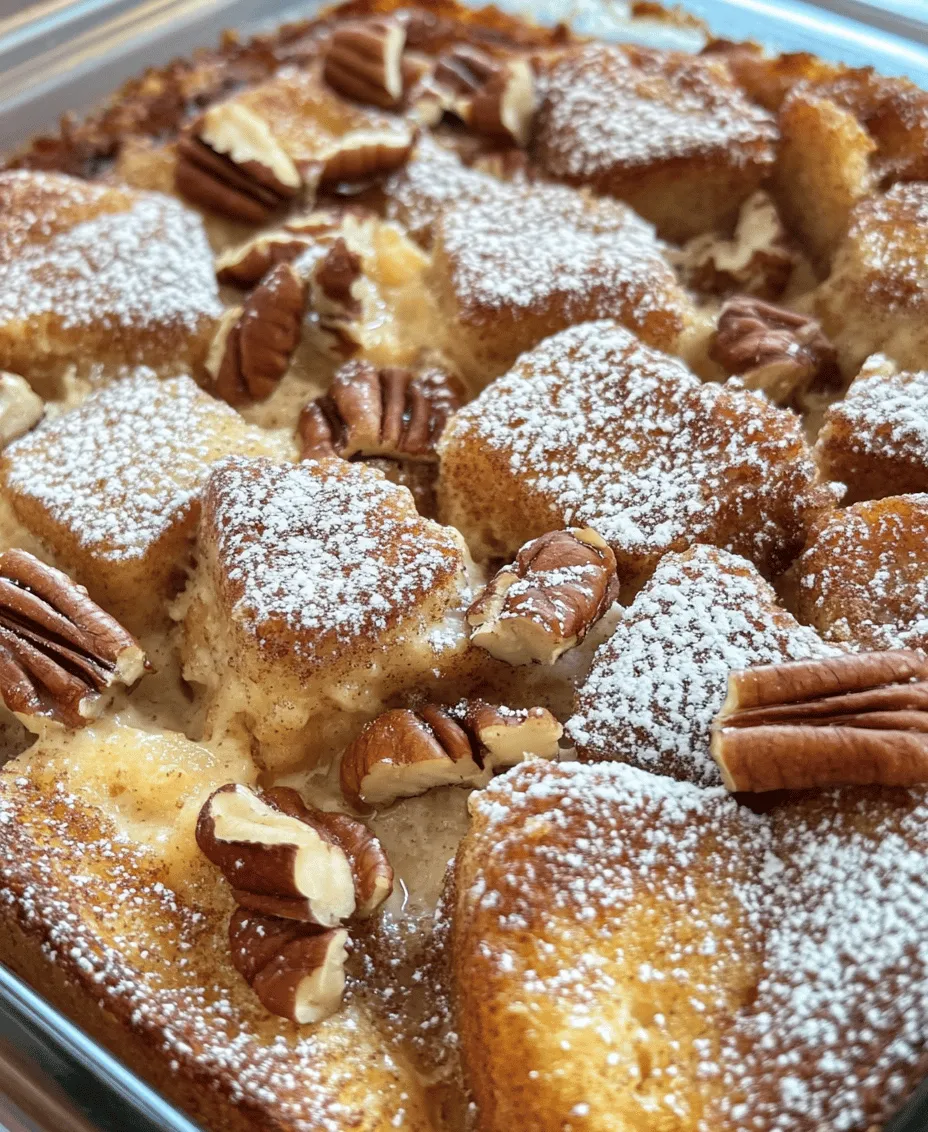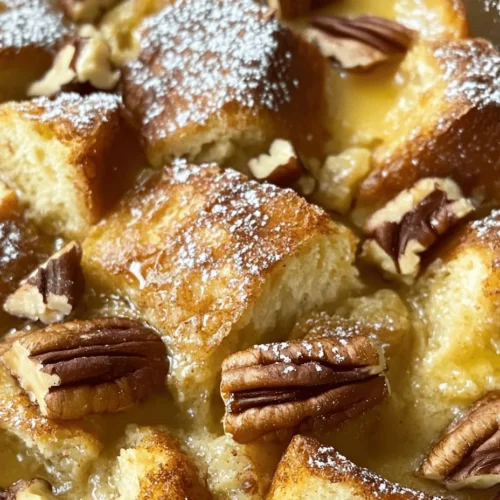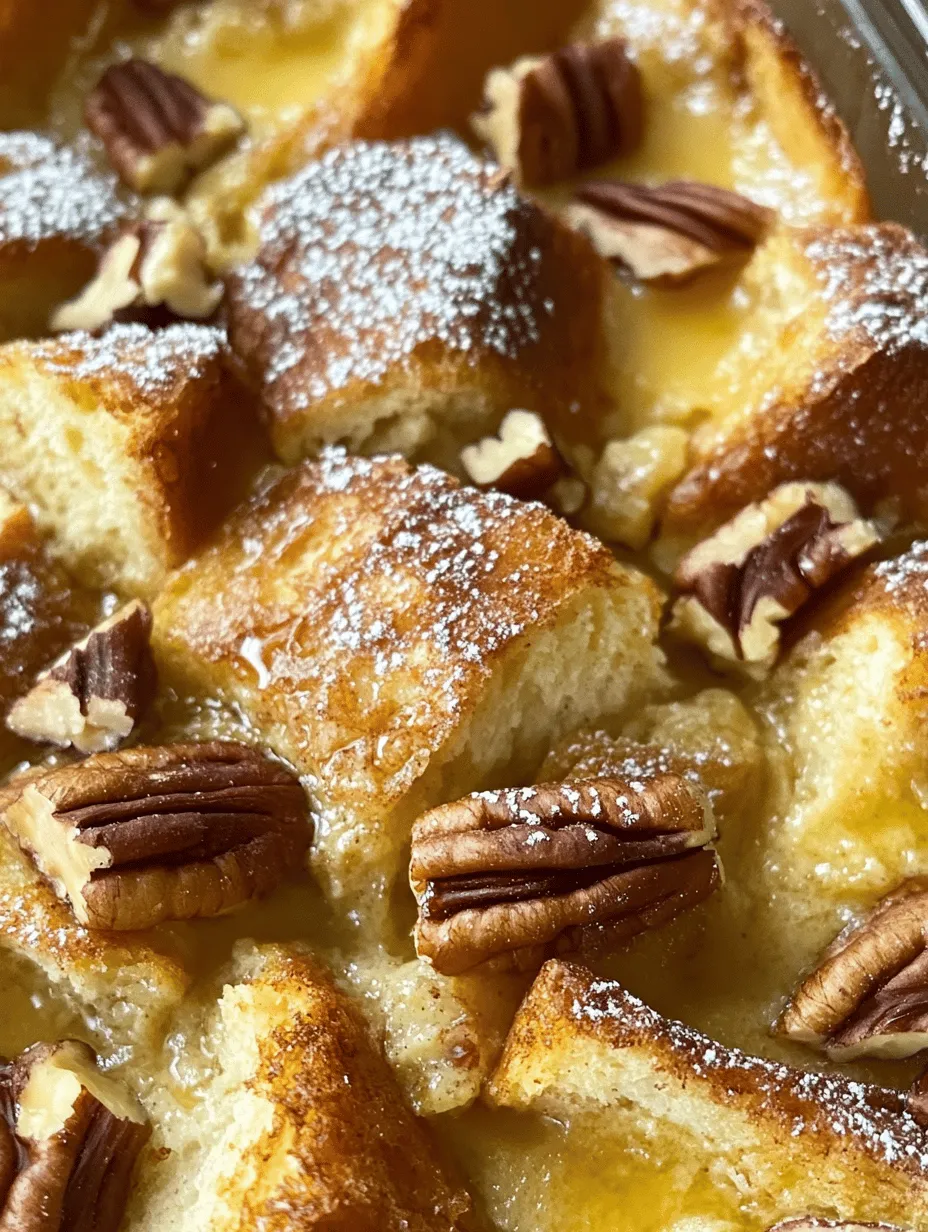Discover the ultimate breakfast indulgence with Baked Brioche French Toast Casserole—a delightful dish that transforms classic French toast into a communal feast. With its rich, buttery flavor derived from brioche bread and a creamy custard that envelops each piece, this recipe results in a perfectly baked casserole that is both comforting and satisfying. Ideal for brunch gatherings, holiday mornings, or simply a cozy family breakfast, this dish is sure to impress and leave your guests asking for seconds.
A Brief History of French Toast
French toast, with its roots tracing back to ancient times, has evolved into a beloved breakfast staple across many cultures. The early versions of this dish were created primarily as a means to use up stale bread, providing a delicious way to prevent food waste. Over centuries, it has transformed into various forms and flavors, with the French style being particularly noted for its luxurious ingredients. The introduction of brioche bread into this classic dish elevates it to a new level of indulgence, making it a favorite for many brunch enthusiasts.
Understanding the Ingredients
Creating the perfect Baked Brioche French Toast Casserole starts with understanding and selecting the right ingredients. Here’s a closer look at the key components that contribute to this delicious dish.
The Importance of Brioche Bread
Characteristics of Brioche: Texture and Flavor
Brioche is a soft and tender bread enriched with butter and eggs, giving it a slightly sweet flavor and a rich, airy texture. This unique combination makes brioche an ideal choice for French toast, as it absorbs the custard mixture beautifully without becoming overly soggy. The subtle sweetness and richness of brioche create a perfect base for the flavors to come.
Why Brioche is the Best Choice for French Toast
Unlike regular bread, brioche holds up well to soaking, allowing it to soak in the custard and develop a custardy interior while still maintaining a fluffy exterior when baked. This characteristic ensures that every bite delivers a luscious, melt-in-your-mouth experience, making each serving of Baked Brioche French Toast Casserole truly special.
The Custard Mixture
The Role of Eggs: Binding and Richness
Eggs play a crucial role in the custard mixture, serving as a binding agent that helps the casserole hold its shape. They also add richness and depth of flavor, contributing to the overall texture of the dish. For the best results, use large eggs, as their size ensures the right balance of moisture and structure.
The Significance of Whole Milk and Heavy Cream for Creaminess
To create a luxuriously creamy custard, a combination of whole milk and heavy cream is recommended. Whole milk provides a smooth base, while heavy cream adds richness and enhances the overall mouthfeel of the dish. This combination results in a custard that is both light and decadent, perfectly complementing the brioche.
Sweeteners: Granulated Sugar vs. Alternatives
Granulated sugar is a common sweetener in French toast casseroles, offering the classic sweetness that pairs beautifully with the other ingredients. However, you can also consider alternatives like maple syrup, honey, or coconut sugar for a different flavor profile. Each sweetener adds its unique touch, allowing you to customize the dish to your taste preferences.
Flavors: Vanilla, Cinnamon, and Nutmeg Explained
Vanilla extract is essential for bringing warmth and depth to the custard. Cinnamon and nutmeg are traditional spices that enhance the overall flavor profile, adding a hint of warmth and spice. Together, these ingredients create a comforting aroma and taste that evoke feelings of nostalgia and satisfaction.
Optional Ingredients and Variations
To make your Baked Brioche French Toast Casserole even more delightful, consider incorporating optional ingredients and variations:
Chopped Pecans: Adding Crunch and Flavor
For those who enjoy a bit of texture, adding chopped pecans to the casserole will not only provide a satisfying crunch but also introduce a nutty flavor that complements the sweetness of the dish.
Other Topping Suggestions: Fruits, Chocolate Chips, and Whipped Cream
Consider adding fresh fruits like berries or bananas for a burst of freshness. Chocolate chips can also be a delightful addition for chocolate lovers, creating a rich and indulgent breakfast experience. Finally, a dollop of whipped cream on top adds a touch of elegance and enhances the overall presentation.
Step-by-Step Instructions
Now that you understand the key ingredients that bring this Baked Brioche French Toast Casserole to life, it’s time to dive into the step-by-step instructions. This guide will ensure you achieve the perfect casserole, making your breakfast gathering a memorable one.
Preparing the Baking Dish
Importance of Greasing the Dish
Before you start assembling the casserole, it’s essential to prepare your baking dish properly. Greasing the dish with butter or non-stick cooking spray prevents the casserole from sticking and ensures easy serving. A well-prepared dish will contribute to the overall texture and appearance of your final dish.
Recommended Baking Dish Size and Materials
For this recipe, a 9×13-inch baking dish is ideal. This size allows the casserole to bake evenly while providing enough space for the brioche and custard mixture. Glass or ceramic baking dishes are preferred, as they distribute heat evenly and allow for easy monitoring of the baking process.
Cubing the Brioche Bread
Tips for Cutting the Brioche Evenly
To ensure even soaking and consistent baking, it’s important to cube the brioche bread into uniform pieces. Aim for cubes about 1-inch in size; this allows them to soak up the custard mixture without falling apart. Use a serrated knife for clean cuts, which will help preserve the soft texture of the bread.
Best Practices for Ensuring Even Soaking
Once the brioche is cubed, place the pieces in the prepared baking dish. To ensure even soaking, gently toss the cubes to distribute them evenly. This will help the custard mixture soak into every piece of bread, resulting in a uniform texture throughout the casserole.
Making the Egg Mixture
Proper Whisking Techniques for a Smooth Custard
In a separate mixing bowl, combine the eggs, whole milk, heavy cream, sugar, vanilla extract, cinnamon, and nutmeg. Using a whisk, beat the ingredients together until smooth and fully incorporated. Make sure there are no streaks of egg remaining; a well-blended custard mixture is key to achieving a creamy texture.
Balancing Flavors and Sweetness
Taste the custard mixture before soaking the bread. If you prefer a sweeter casserole, feel free to adjust the amount of sugar according to your taste. Remember that the brioche is naturally sweet, so it’s important to find the right balance that suits your palate.
Soaking the Bread
Once your custard mixture is ready, it’s time to soak the brioche cubes. Pour the custard evenly over the bread, ensuring that every piece is coated. Gently press down on the bread with a spatula or your hands to encourage absorption. Allow the mixture to soak for at least 30 minutes, or for best results, cover the baking dish and refrigerate it overnight. This extended soaking time allows the flavors to meld and the bread to fully absorb the custard, creating a rich and flavorful casserole.
In the next part of this article, we will discuss the baking process, tips for achieving the perfect golden crust, and serving suggestions to elevate your Baked Brioche French Toast Casserole experience. Stay tuned for the delicious continuation of this recipe journey!

Techniques for Ensuring Even Soaking
To achieve the perfect Baked Brioche French Toast Casserole, it’s crucial to allow the brioche bread to soak evenly in the custard mixture. Here are some techniques to ensure thorough soaking:
1. Cut Consistently: Begin by cutting your brioche into uniform cubes, typically about 1-inch in size. Uniformity helps the bread absorb the custard evenly, preventing some pieces from becoming soggy while others remain dry.
2. Layering Method: When layering the bread cubes in your baking dish, alternate with the custard mixture. Start with a layer of bread, pour over some of the custard, then add another layer of bread followed by more custard. This technique ensures that every piece of bread is coated and soaked through.
3. Gentle Pressing: After pouring the custard over the layered bread, gently press down on the bread with a spatula or the back of a spoon. This will help the bread absorb the liquid more effectively.
Benefits of Refrigerating the Mixture: Overnight vs. A Few Hours
Refrigerating the custard-soaked brioche is a crucial step that can enhance the flavors and texture of your casserole:
– Overnight Refrigeration: Allowing the casserole to sit overnight is ideal for optimal flavor infusion. This extended soaking time lets the custard fully permeate the brioche, resulting in a richer taste and creamier texture. The spices and vanilla also have more time to meld, creating a more complex flavor profile.
– A Few Hours: If time is of the essence, refrigerating the mixture for at least two hours can still yield good results. While the flavors may not be as pronounced as with overnight soaking, the bread will still absorb a significant amount of custard, leading to a delicious outcome.
Baking the Casserole
Pre-Baking Preparation: Letting It Come to Room Temperature
Before placing your casserole in the oven, remove it from the refrigerator and let it sit at room temperature for about 30 minutes. This step is important as it allows the casserole to come to a more uniform temperature, which helps it bake evenly. If you bake it straight from the fridge, the outer edges may cook faster than the center, resulting in an uneven texture.
Baking Temperature and Time Considerations
For the perfect bake, preheat your oven to 350°F (175°C). This temperature allows the casserole to cook through without burning the top. Bake the casserole for 45-55 minutes, keeping a close eye on it during the last 10 minutes. If you notice the top browning too quickly, you can cover it loosely with aluminum foil to prevent burning.
Signs of Doneness: Golden Top and Clean Toothpick Test
To check for doneness, look for a golden-brown top; this is an indicator that the casserole is likely ready. Additionally, insert a toothpick into the center of the casserole. If it comes out clean or with a few moist crumbs (not wet batter), your casserole is finished baking.
Adding Toppings
Timing for Adding Pecans or Other Toppings
If you’re adding crunchy toppings like pecans or walnuts, it’s best to do this about 10-15 minutes before the casserole is finished baking. This timing allows the nuts to toast slightly, enhancing their flavor without burning.
Drizzling Maple Syrup: When and How for Maximum Flavor
For an indulgent finishing touch, drizzle maple syrup over the casserole just before serving. This can be done after removing it from the oven and allowing it to cool for a few minutes. Serving warm syrup enhances the overall flavor and adds a pleasant sweetness that pairs beautifully with the richness of the brioche.
Serving Suggestions
Presentation Techniques
When it comes to serving your Baked Brioche French Toast Casserole, presentation can elevate the dining experience:
– Cutting and Serving: Use a sharp knife to cut the casserole into squares or rectangles. For a more elegant touch, serve individual portions in ramekins or small cast-iron skillets. This not only looks appealing but also allows for personalization with toppings.
– Creative Serving Ideas: Consider serving the casserole family-style, directly from the baking dish, with a large spoon for guests to help themselves. Alternatively, arrange the pieces on a platter and garnish with fresh berries, a dusting of powdered sugar, or whipped cream for a festive look.
Pairing Ideas
To complement your Baked Brioche French Toast Casserole, consider the following beverages and side dishes:
– Complementary Beverages: A robust cup of coffee or a fragrant herbal tea pairs wonderfully with the sweetness of the casserole. Alternatively, fresh-squeezed orange juice or a fruity smoothie can add a refreshing contrast.
– Side Dishes that Enhance the Meal: Serve with crispy bacon or sausage links for a savory balance. Fresh fruit salad or yogurt can also add a healthy and refreshing element to your breakfast or brunch spread.
Exploring the Versatility of Baked French Toast Casserole
Customization Options
One of the best things about Baked Brioche French Toast Casserole is its adaptability:
– Flavor Variations: Feel free to experiment with seasonal fruits such as apples, pears, or berries. You can also add spices like nutmeg or cardamom for a warm, aromatic touch. Adding a splash of liqueur like Grand Marnier can give your dish an adult twist for brunch gatherings.
– Gluten-Free and Dairy-Free Adaptations: For those with dietary restrictions, substituting gluten-free bread and using almond or oat milk can make this dish accessible without sacrificing flavor. Just make sure to use a firm bread that can hold up to the soaking process.
Storage and Reheating
Best Practices for Storing Leftovers
If you have any leftovers, allow the casserole to cool completely before covering it tightly with plastic wrap or aluminum foil. It can be stored in the refrigerator for up to 3 days, or you can freeze it for up to a month. Just be sure to wrap it well to avoid freezer burn.
How to Reheat for Optimal Taste and Texture
To reheat, preheat your oven to 350°F (175°C), then place the casserole in an oven-safe dish. Cover with foil to retain moisture and heat for about 20-25 minutes, or until warmed through. For a crispy top, remove the foil during the last 5-10 minutes of reheating.
Conclusion
Baked Brioche French Toast Casserole stands out as a decadent breakfast option that is not only easy to prepare but also versatile enough to suit various tastes and occasions. By understanding the nuances of the ingredients and following the detailed preparation steps, anyone can create a delicious, crowd-pleasing dish that elevates any breakfast or brunch gathering. Enjoy the warm, comforting flavors of this casserole, and let it become a cherished recipe in your culinary repertoire. With its delightful combination of textures and flavors, this dish promises to become a beloved staple for family gatherings, festive occasions, or simply a cozy weekend brunch at home.



